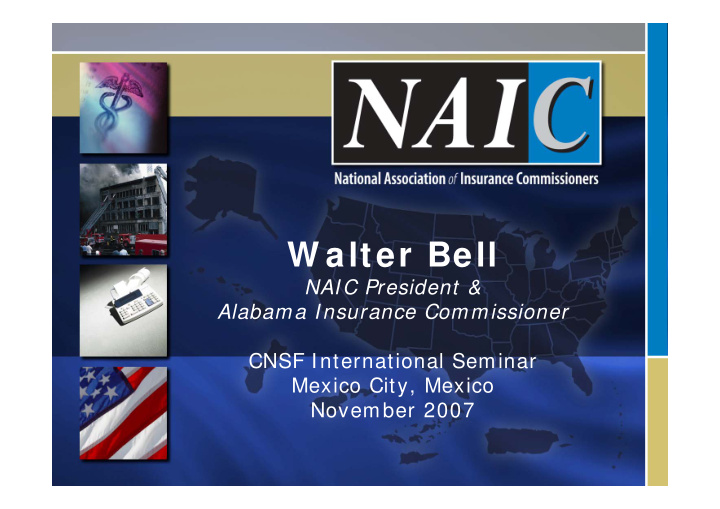



W alter Bell NAIC President & Alabama Insurance Commissioner CNSF International Seminar Mexico City, Mexico November 2007
Insure U Get Smart About Insurance
NAI C Mission: • To promote the public interest • To promote competitive markets • To facilitate the fair and equitable treatment of insurance consumers • To promote the reliability, solvency and financial solidity of insurance institutions • To support and improve state regulation of insurance
Get Sm art About I nsurance The basics Auto Hom e Life Health Life stages Em pty Nesters/ Young Singles Young Fam ilies Established Seniors Fam ilies
w w w .I nsureUonline.org
w w w .I nsureUonline.org
w w w .I nsureUonline.org
w w w .I nsureUonline.org/ espanol
Fight Fake I nsurance
Fight Fake I nsurance
Fight Fake I nsurance More than 150 Million Impressions InsureUonline.org
Press Releases
Press Coverage
I nsure U for Sm all Business
Tool Kit
I nsure U in the States States mentioning Insure U on their sites or linking to Insure U site AL, AR, AZ, CT, DE, DC, GA, HI, ID, IN, KS, KY, ME, MD, MN, MS, NC, ND, NH, NJ, OH, OK, OR, PA, SC, SD, TN, UT, VT, WV
Results Outstanding Results – Strong Web traffic at all Insure U Web sites • 1 7 6 ,8 5 6 total visits since launch (March 2006) • Average of 5 7 1 visits per day • 4 ,8 9 3 diplomas downloaded
Natural Disasters in the US
States W ith Significant Risk of: EARTHQUAKE Sources: U.S. Geological Survey, Uniform Sources: U.S. Geological Survey, Uniform Building Codes, Council of State Governments Building Codes, Council of State Governments
States W ith Significant Risk of: HURRICANE Sources: U.S. Geological Survey, Uniform Sources: U.S. Geological Survey, Uniform Building Codes, Council of State Governments Building Codes, Council of State Governments
States W ith Significant Risk of : EARTHQUAKE HURRICANE BOTH TORNADOS Sources: U.S. Geological Survey, Uniform Sources: U.S. Geological Survey, Uniform Sources: U.S. Geological Survey, Uniform Sources: U.S. Geological Survey, Uniform Sources: U.S. Geological Survey, Uniform Sources: U.S. Geological Survey, Uniform Building Codes, Council of State Governments Building Codes, Council of State Governments Building Codes, Council of State Governments Governments Building Codes, Council of State Governments Building Codes, Council of State Governments Building Codes, Council of State
States W ith Significant Risk of : EARTHQUAKE HURRICANE BOTH Sources: U.S. Geological Survey, Uniform Sources: U.S. Geological Survey, Uniform Building Codes, Council of State Governments Building Codes, Council of State Governments
Creating A Comprehensive National Catastrophe Plan
Basic Underlying Principles • A national program should promote personal responsibility among policyholders • A national program should support reasonable building codes, development plans, and other mitigation tools; • A national program should maximize the risk- bearing capacity of the private markets, and; • A national plan should provide quantifiable risk management to the federal government
Current Plan Fram ew ork • 3 layers in the plan – Private market, tax-deferred catastrophe reserves, mandatory offer of “all-perils” policy, mandatory for mortgages with federal guarantees – Optional State or Regional Catastrophe Funds – Federal Backstop beyond some “high” level for participating states at actuarially sound rates
The Plan Schem atic Federal Backstop State/Regional Catastrophe Funds State Attachment Private Insurance Private Reinsurance Policy Holder Retention via deductible -personal responsibility
Main Features of Hom eow ners Protection Act of 2 0 0 7 • Creates a 3 layer program relying on the private market, state involvement and finally a federal reinsurance backstop
Main Features of Hom eow ners Protection Act of 2 0 0 7 • Creates Catastrophe Capital Reserve Funds for private insurers; tax-deferred reserves that can be used for paying claims resulting from 1: 100 year or higher events • Creates a Federal Reinsurance Program, with caps, for states with qualifying state or regional catastrophe fund. Trigger of 1: 200 year or higher event • Only states participating with state cat funds or participating in regional funds have access to Federal reinsurance
State or Regional Cat Funds • Funds act as “reinsurers” and are required to participate in Federal Reinsurance Program • State must adopt mitigation and prevention standards along with building code and enforcement standards • A minimum of $10 million must be spent annually on prevention and mitigation
Federal Reinsurance Program • Sells annual contracts to participating state or regional funds at actuarially sound and self sustaining rates • Trigger for federal reinsurance payout is a 1: 200 yr or greater event • Program is capped at a $200 billion aggregate liability per contract year
Additional Research Mandates • Secretary of Treasury will report annually on the cost and availability of homeowners’ insurance in catastrophe prone areas and offer suggestions for improvement • Mandates a GAO study on the interrelation between flooding and hurricane.
Moving Forw ard • Continue with Efforts as Enumerated in the NAIC Resolution adopted in 2005 • Continue Moving Forward with the Catastrophe Insurance Working Group to study additional considerations
For Consideration • At the basic layer, the homeowner’s policy will be an “all-perils” policy, e.g. all natural disasters • The NFIP should be structured as a reinsurer to the private market, not a direct writer • The homeowner’s policy will have a plain English checklist of coverage
For Consideration • States participating in state or regional funds with mitigation, building and development standards will be the only ones that may participate in a Federal backstop reinsurance program • The Federal reinsurance backstop must be priced at actuarially sound and self-sustaining rates • Other Options: – TRIA style program for natural catastrophes – Regional Catastrophe Plans
GRACIAS! Walter Bell Walter.Bell@insurance.alabama.gov
Recommend
More recommend